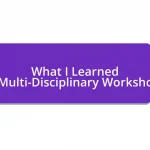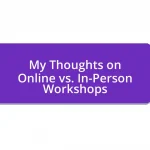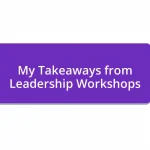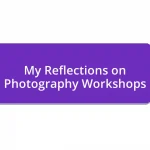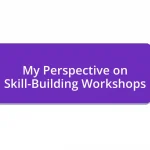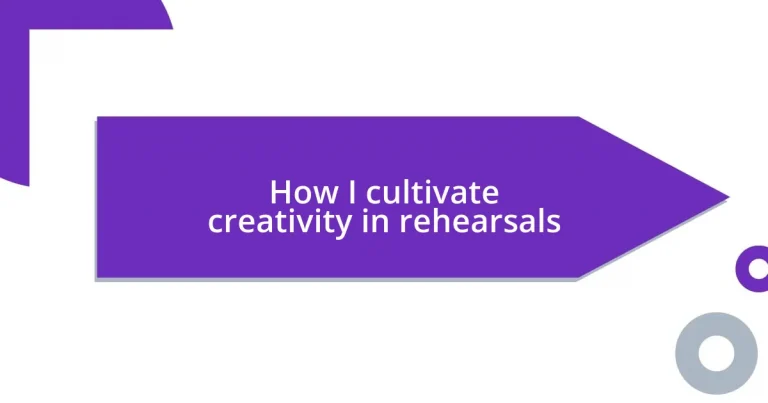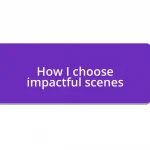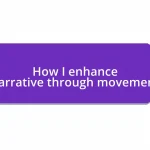Key takeaways:
- Creativity in rehearsals thrives in a supportive environment where all ideas are welcomed and spontaneous changes are embraced.
- Utilizing improvisation techniques and structured brainstorming sessions enhances character understanding and encourages unique interpretations.
- Open communication and integrating diverse perspectives lead to richer performances and foster a culture of inclusivity and collaboration.
- Reflecting on creative outcomes helps teams recognize valuable insights and adapt their approaches for future rehearsals.
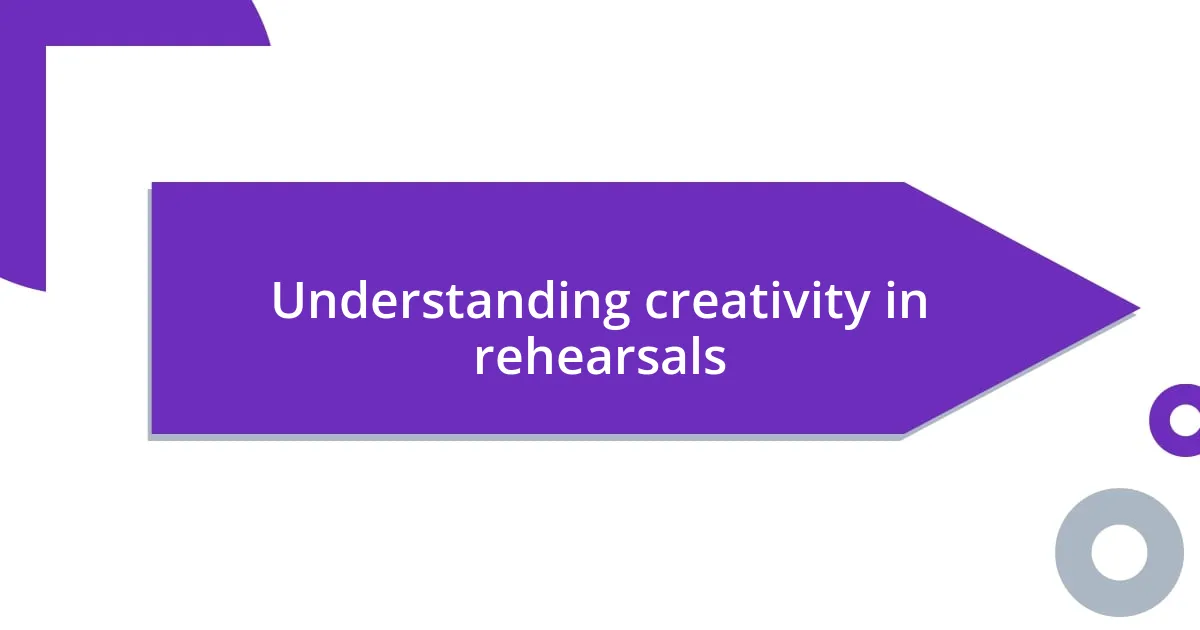
Understanding creativity in rehearsals
When I think about creativity in rehearsals, it’s fascinating how it can lead to fresh interpretations and unexpected moments. I remember a time when we completely deviated from the script during a run-through, allowing ourselves to explore impulsive character choices. This spontaneity not only shocked us but also opened a dialogue about our characters’ motivations that we hadn’t considered before.
Creativity, I believe, thrives on a supportive environment where everyone feels empowered to share their ideas—no matter how wild they might seem. Have you ever noticed how a simple change in blocking can completely alter a scene’s emotional weight? During one rehearsal, we decided to rearrange the seating during a pivotal moment, transforming what was a static exchange into a dynamic confrontation. That day, I learned that creativity flourishes when we embrace experimentation and trust our instincts.
Moreover, there’s something intimate about collective brainstorming within a rehearsal setting. I can still feel the buzz from a session where we passed around a “creativity ball”—a literal object that signified the speaker’s turn, sparking an avalanche of playful ideas. It made me realize that creativity isn’t just an individual endeavor; it’s a tapestry woven from the threads of our shared experiences and insights. This vibrant exchange of ideas can lead to breakthroughs that ultimately elevate the entire production.
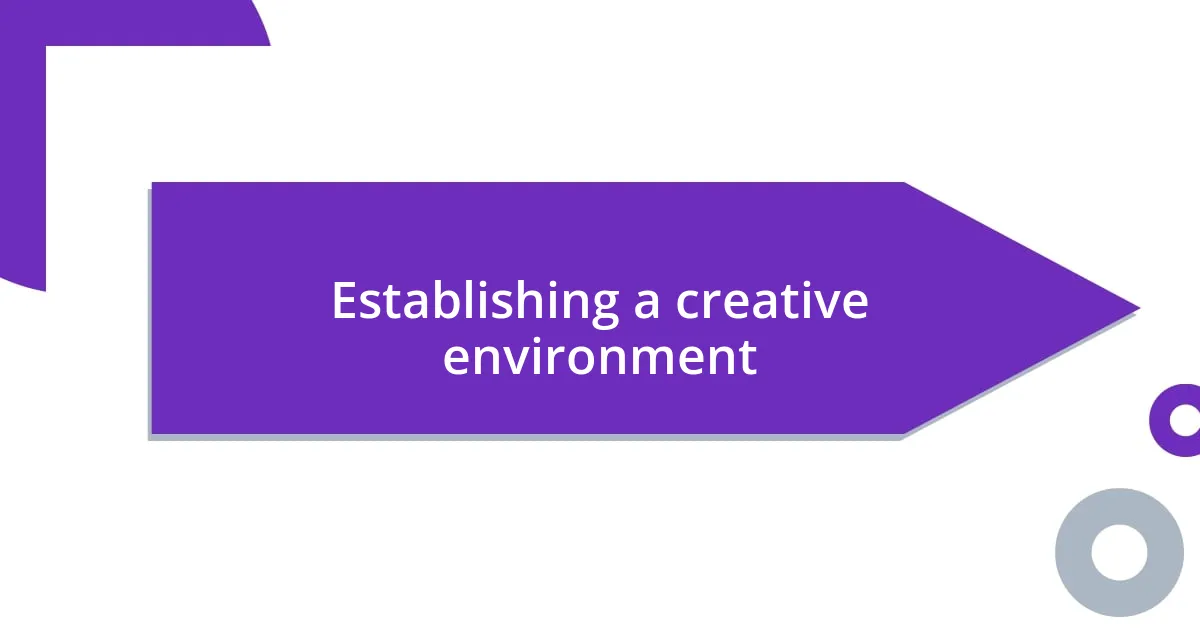
Establishing a creative environment
Creating an environment that nurtures creativity is essential for effective rehearsals. I vividly recall a rehearsal where I transformed our usual space by dimming the lights and introducing ambient music. The atmosphere shifted; we became more relaxed and open, allowing our improvisations to soar. It was as if we had entered a different world, and suddenly, our ideas flowed more freely, turning a straightforward read-through into a vibrant exchange filled with surprises.
To establish a truly creative environment, consider these elements:
- Comfort: Provide a space where everyone feels physically and emotionally safe to express themselves.
- Mood: Play music or adjust lighting to inspire different emotions and spur creativity.
- Flexibility: Allow for spontaneous changes in the schedule or format; leave room for exploration.
- Collaboration: Foster a culture where every voice matters, whether it’s sharing ideas or brainstorming solutions.
- Visual Stimuli: Use props or pictures that inspire curiosity. I once put up a collage of diverse artwork, and it led to remarkable conversations about our characters and themes.
Through these practices, I’ve seen our rehearsals evolve into a playground of imagination, where creativity can truly flourish.
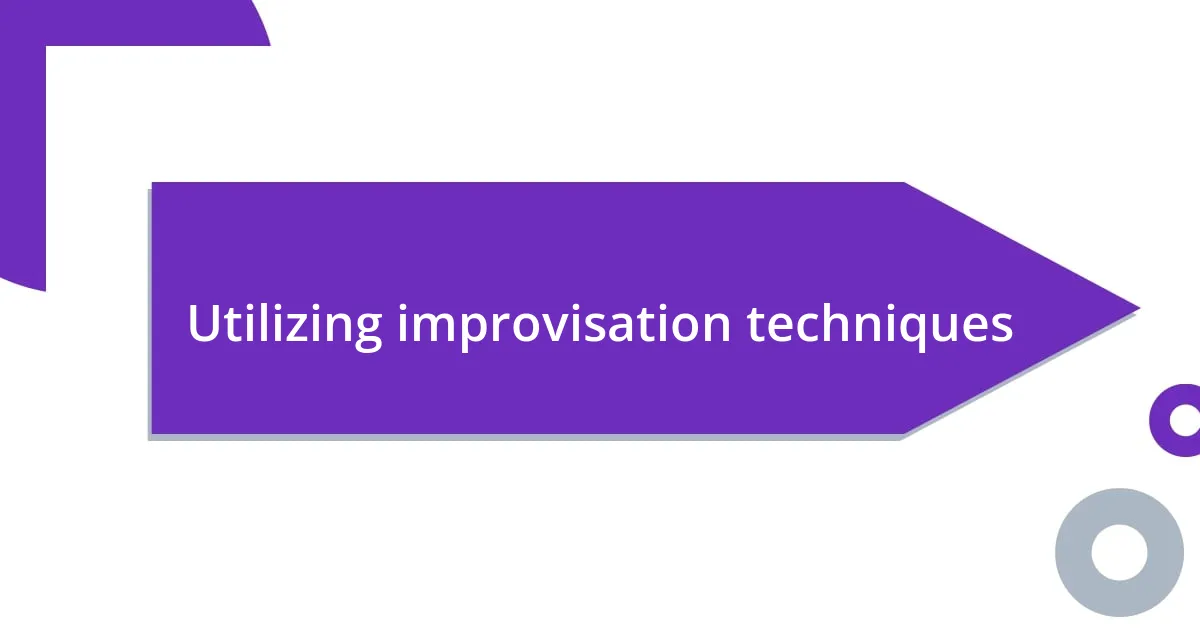
Utilizing improvisation techniques
Utilizing improvisation techniques offers incredible opportunities to spark creativity during rehearsals. I vividly remember a scenario where we engaged in an improvisation exercise that required us to switch our characters’ motivations midway through a scene. The initial awkwardness quickly turned into a burst of laughter and insight as we stumbled upon unexpected dynamics, creating a richer tapestry for our characters. This exercise wasn’t just fun; it redefined how we viewed our roles and the relationships within the script.
One of the most thrilling aspects of improvisation is the element of surprise. During one rehearsal, we experimented with a technique where each actor had to respond to the previous line with a completely different emotional tone than intended. The shift in energy led to some genuinely humorous exchanges that we later integrated into our final performance. I found that it encouraged everyone to think on their feet and cultivate adaptability, which is crucial in live theater—who knows when a prop might fail or a line might be missed?
In my experience, mixing improvisation with structured rehearsals creates a balanced dynamic that enhances creativity. By allocating time for free play, we allowed our instincts to guide us, resulting in each rehearsal becoming a unique experience. I often think about how some of our best moments emerged from those playful detours, reminding me that creativity isn’t just about the final product—it’s about enjoying the journey together.
| Improvisation Technique | Example from Experience |
|---|---|
| Character Motivation Switch | Switching motives during a scene led to laughter and deeper character understanding. |
| Emotional Tone Variation | Responding with unexpected emotions created humorous and memorable exchanges. |
| Free Play Integration | Allocating time for improvisation resulted in unique and spontaneous rehearsal experiences. |
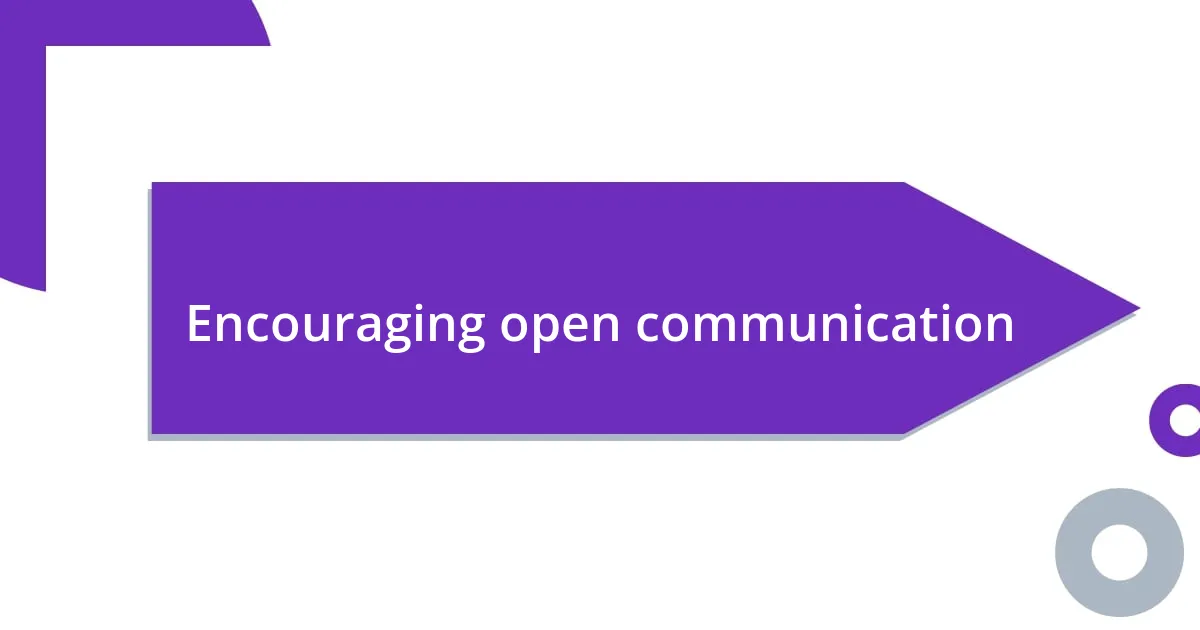
Encouraging open communication
Encouraging open communication is fundamental in cultivating creativity during rehearsals. I remember a moment when I encouraged my team to share their thoughts openly about a sticky scene we were struggling with. This led to an unexpected brainstorming session, where every actor contributed ideas, building a sense of camaraderie. I realized then that when individuals feel heard, they tend to take more creative risks, enriching the entire process.
I often find that simply asking open-ended questions can break through barriers of communication. For instance, during one rehearsal, I asked, “What if we completely change the character’s objective in this scene?” That question opened the floodgates, allowing my fellow actors to reimagine their performances in ways that I hadn’t anticipated. It was amazing to see how everyone’s energy shifted, sparking new ideas and deeper character connections. Have you ever noticed how a single question can change the course of a conversation? It’s empowering.
Furthermore, I’ve learned the value of creating designated times for feedback within our rehearsal schedule. In one memorable instance, we dedicated the last 15 minutes of our sessions to share constructive thoughts on each other’s performances. This practice not only gave everyone a voice but also fostered a deeper trust among us. By maintaining an atmosphere where communication is encouraged, I’ve observed how much our creativity flourishes, transforming the rehearsal space into a thriving hub of innovation.
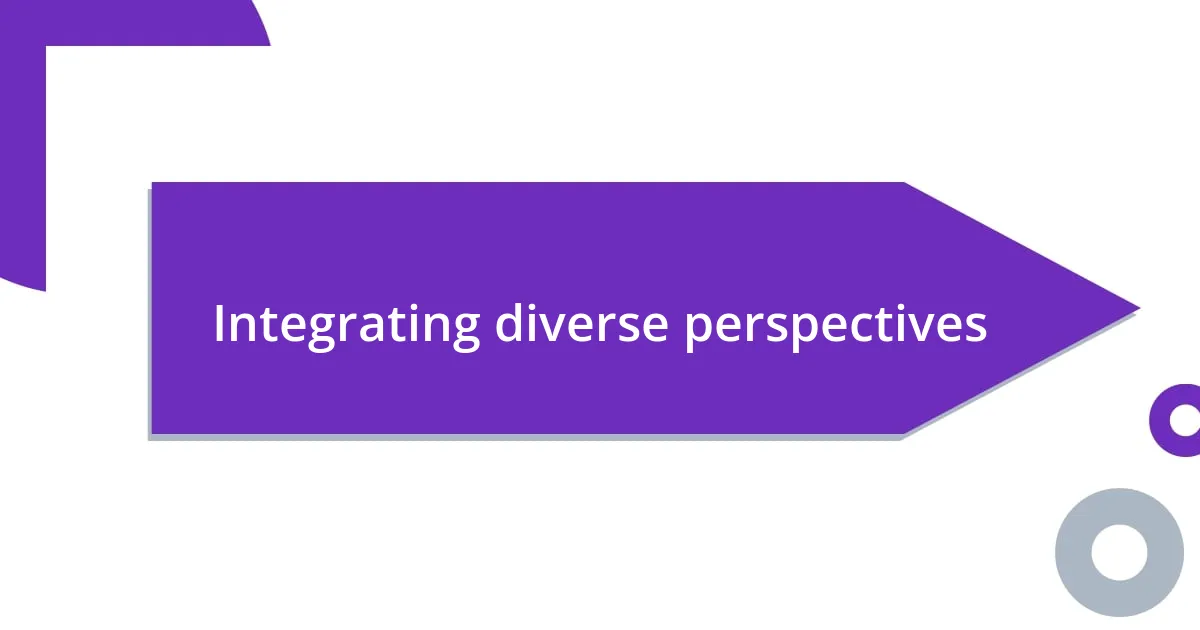
Integrating diverse perspectives
Integrating diverse perspectives can truly breathe fresh life into rehearsals. I recall a time when we brought together actors from various backgrounds—some were seasoned veterans while others were fresh faces. The discussions that followed were eye-opening; each individual added their unique interpretations and experiences, which reshaped how we approached our scenes. It taught me that when we embrace different viewpoints, we don’t just create a more dynamic performance; we foster an environment ripe for innovation.
During another rehearsal, I suggested we invite a guest director to observe our progress. Their external viewpoint led to a profound shift in our understanding of the material. They pointed out nuances in our performances that we had overlooked, highlighting how our varied backgrounds influenced our interpretations of the text. This singular experience made me ponder: How often do we overlook the power of external perspectives? It’s an invaluable tool, encouraging us to step outside our comfort zones and explore new artistic possibilities.
Ultimately, integrating diverse perspectives isn’t merely about gathering different opinions; it’s about cultivating a culture of inclusivity that celebrates individuality. I’ve found that when everyone feels empowered to express their thoughts, the creative synergy grows exponentially. One particularly poignant rehearsal stood out for me—after allowing everyone to share their interpretations of a pivotal scene, we ended up crafting a completely different approach that resonated on an emotional level. This experience solidified my belief that when we unlock the collective potential of our team, we create something profoundly transformative together.
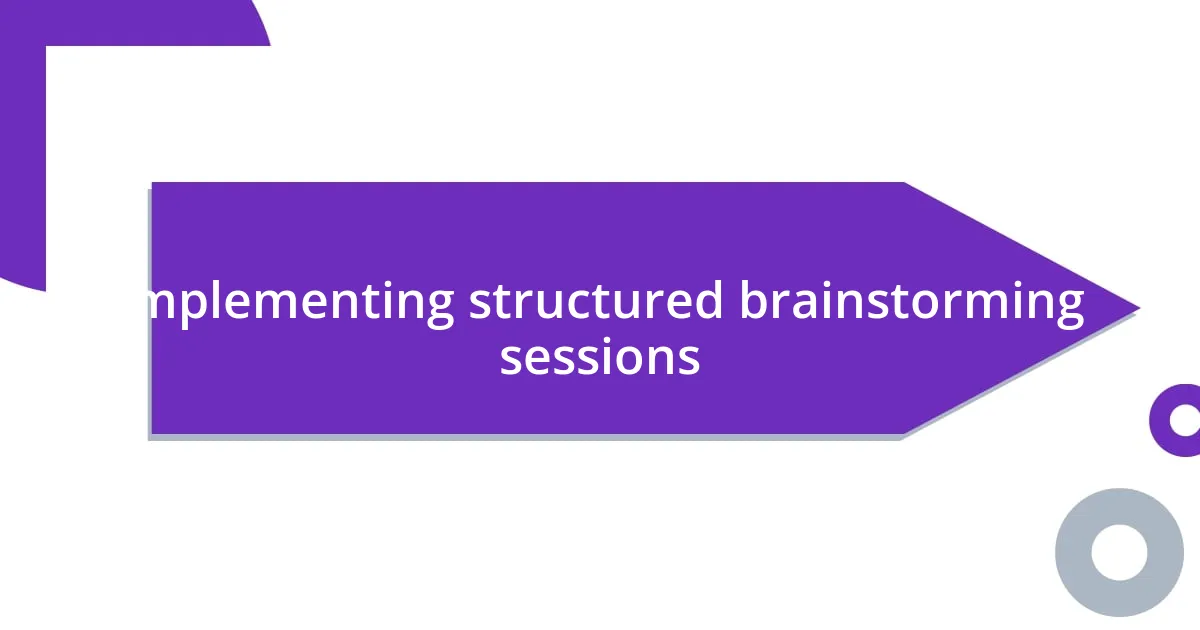
Implementing structured brainstorming sessions
Implementing structured brainstorming sessions has been a game changer in my rehearsals. I remember one particular session where we allocated a full hour specifically just for brainstorming ideas about a challenging scene. As we began to sketch out potential solutions, I was amazed at how the energy shifted; it felt like everyone suddenly had a stake in the creative process. Have you ever felt that thrill when a room comes alive with ideas? It’s an exhilarating experience that can really propel a project forward.
One effective technique I’ve adopted is the “round-robin” approach during these brainstorming sessions. Every person gets a chance to share an idea, no matter how wild it might seem. I vividly recall a time when one actor suggested something completely unconventional—turning a dramatic scene into a comedic moment. At first, we all chuckled, but as we explored it further, we found a fresh angle that ultimately enhanced the depth of the characters involved. When do you find that an unexpected idea sparks something magical? I believe that’s where the real magic happens—when you give freedom to ideas, no matter how unconventional.
To keep the momentum going, I often establish specific themes for each brainstorming session. For instance, one time, we focused solely on character motivations, asking, “What deeper drives them?” This led to rich discussions about our characters’ backstories and desires. Some actors even shared personal experiences that reflected their characters’ journeys, further deepening our collective understanding. How valuable is it to connect personal insights to our artistic work? In my experience, it reinforces a sense of authenticity that enriches everyone’s performance, allowing for a more cohesive and inspired ensemble. Each brainstorming session has the potential to unlock new dimensions of creativity, transforming rehearsals into collaborative art-making experiences.
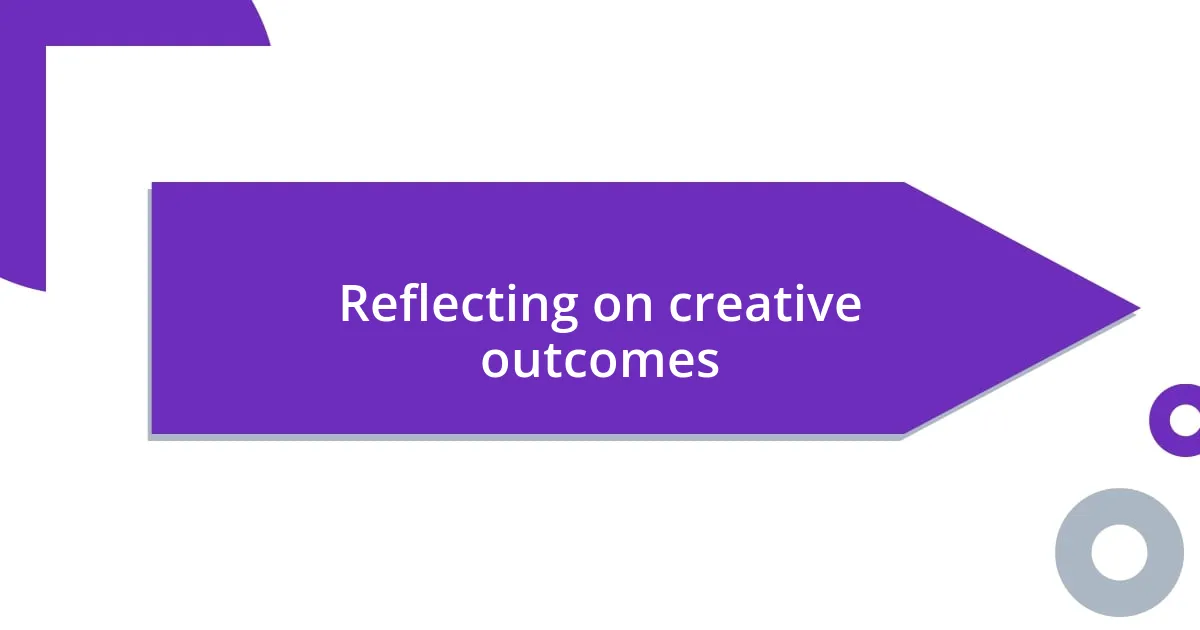
Reflecting on creative outcomes
Reflecting on creative outcomes is a vital part of the rehearsal process for me. After each session, I take a moment to gather the team and discuss what worked well and what didn’t. I remember one rehearsal where we tried a new staging that initially felt chaotic. However, as we reflected together, we realized that the tension added depth to our performance, transforming that chaos into something compelling. Isn’t it refreshing to find clarity in what seemed confusing at first?
Sometimes, I jot down notes about the ideas and approaches we explored, capturing the essence of our discussions. One rehearsal involved experimenting with music, and I wasn’t sure it would fit the scene at all. Yet, after reflecting on the outcomes, I recognized how the right soundtrack had enhanced the emotional resonance, allowing our characters to connect more authentically. Have you ever experienced an unexpected outcome that changed your perspective? It’s fascinating how looking back can reveal insights we might have missed in the moment.
I’ve also found value in creating a feedback loop, where we regularly revisit our previous creative choices. During one production, we tracked how specific changes impacted audience reactions, and the feedback opened our eyes to different interpretations. It made me appreciate the importance of not just creating but nurturing an ongoing dialogue about our artistic choices. How often do we sustain a conversation about our creative journey? Embracing that dialogue has deepened my understanding of the collaborative spirit, demonstrating how much richer our collective creativity can become when we reflect on our journeys together.
